Abstract
Previous studies on the impact of FDI on GDP concluded that there was no long run relationship between the two. The Granger Casual analysis provided this inference. Sirari & Bohra (2011) provide a conceptual framework to explain the relationship between GDP and FDI inflows.
Technology and knowledge transfers provide the key indications for the relationship. The pattern on annual FDI inflow as a percentage of GDP shows an exponential growth over time. Over the years, India’s FDI inflows have surpassed outflows.
There were more sources of FDI inflow from the western hemisphere; however, Mauritius was the highest contributor. The services sector received more FDI inflows.
Introduction
According to Chaturvedi (2011, p. 528), foreign direct investment (FDI) is a form of long-term international capital transfer meant for productive activity coupled with the purpose of managerial control and the involvement in the management of the foreign company.
Sirari & Bohra (2011) refer FDI as a tool intended for economic growth by strengthening the local capital, productivity and employment.
Moreover, it has an important role in the local technology advancement, optimal utilization of local manpower, trade balance, enhancing human skill as well as improving of the managerial capacities.
In addition, FDI improves the local competition standards, broadens choices for the overseas market as well as creates more employment opportunities. Chaturvedi (2011, p. 532) explains that FDI has greatly influenced the achievement of economic development in developing countries.
Moreover, developing countries have benefited greatly from FDI inflows as a source of foreign financing. Inflows refer to inbound capital by foreign investors. Availability of highly skilled manpower facilitates the positive impact of FDI inflows on the economic growth (GDP) (Agrawal & Khan 2011, p. 74).
Hansen & Rand (2005) investigated the existence of the Granger Casual nexus between FDI and GDP among selected developing countries. The analysis data was accumulated for over 30 years. The findings showed that there existed a two-way causal relationship between the ratio and the levels of GDP and FDI inflows.
It was established that the FDI to GDP ratio was not affected in the long-run by the GDP. This revelation formed the bases for concluding that FDI had an impact on GDP. FDI augments the rate of investment in a host country resulting in a transitional rise in per capita income growth.
Evidence on the FDI impact on GDP relates to technology and knowledge transfers (Jayachandran & Seilan 2010, p. 74). This is captured in the New Growth Theory of the 1980s.
Based on the computation from twenty years data, inferences showed that the FDI inflows into India have an insignificant contribution to the real GDP. Data was collected during the domestication of the open door policy.
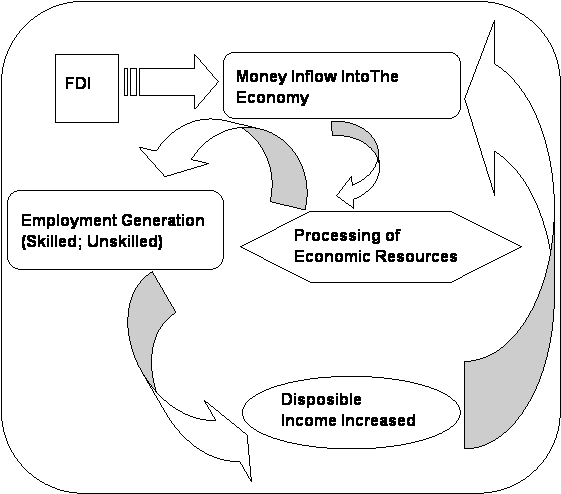
Literature Review
Prior to 1991, India’s state administration applied strong control over industrial investment by regulating and fostering internally-driven economic progress. The approach used favoured domestic investment at the expense of foreign investors and imports (Beena et al. n.d.).
The country experienced dismal development and growth. Imports were restricted through controls as well as high duties. Thus, the Indian strategy on FDI was about reversing inflow influx.
The main argument was to cushion opportunities within the local labour market from the foreign expatriates; however, economic inefficiencies were introduced in due course. Interested foreign investors were faced with bureaucratic procedures before acquiring approvals to establish businesses.
These were deliberately introduced through the Industries Development and Regulation Act (1951). Foreign investment industries ended up using average technologies in production processes affecting their efficiency.
This diminished foreign capital and technology causing difficulties in achieving global efficiency and production standards (Beena et al. n.d.). Due to heavy government infiltration on the financial and banking sector; there was a lot of manipulation of prices and credit allocation.
Small industry players benefited a lot from loans and borrowings. Some sectors were reserved for government investment; thus, affecting competitive bidding. The government focussed on accumulating savings to fast-track local investment as explained in the Harrod-Domar growth paradigm (Beena et al. n.d.).
These affirmative approaches led to financial authoritarianism brought about by unjustified price changing as well as credit favours. Harrod-Domar model investigated relationship between natural and warranted trends of growth. Economic issues were put into perspective through short run tools economic tools.
Nevertheless, the Harrod-Domar model faced strong criticism from the neo-classical economics. Endogenous growth model formed the third paradigm explaining FDI inflows relationship with GDP performance (Sahoo & Mathiyazhagan 2002, p. 8).
Post 1991, the industrial and economic policies were revisited with reference to the strategic approach to FDI. A liberal approach was adopted to stimulate investment as well as accelerate economic growth. Bureaucratic barriers were abolished for most sectors except for 18 industry types.
Reduced barriers of entry gave room to the invigoration of the private sector. During the new dispensation, automatic approvals were awarded to FDI by the Reserve Bank of India (RBI). FDI benefited from the rid-off of excess technology restrictions and royalty fees for technology transfer.
Some of the Pro-FDI reforms introduced in the India’s public sector enterprises focused on enhancing autonomy, lower monopoly within the public sector as well as foster privatisation.
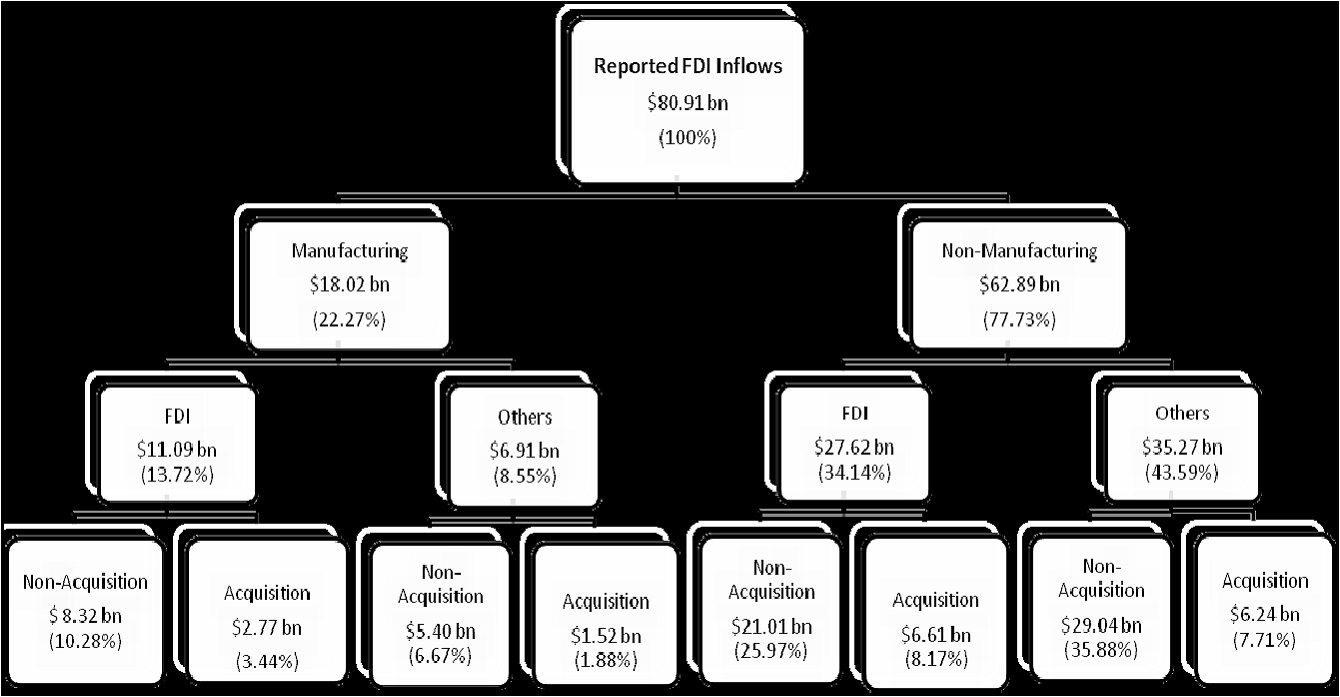
There are hotspot areas within India perceived to have a relatively high attraction for FDI investment. Some of the hotspots have already converted the potential into opportunities.
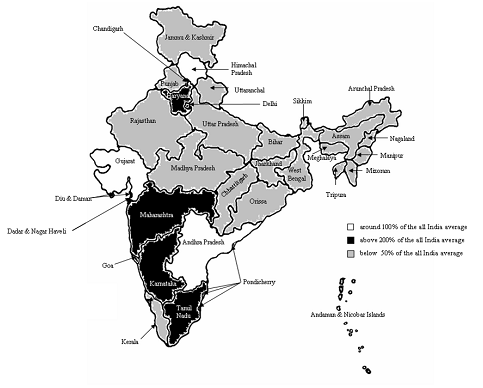
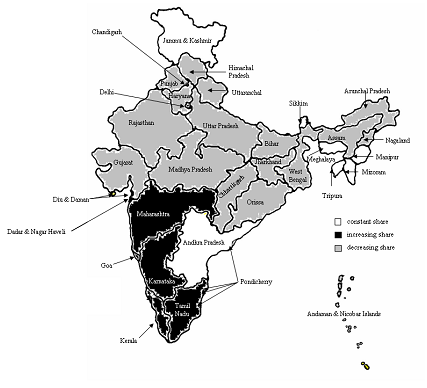
Analysis
Nunnenkamp & Stracke (2008, p. 55) observe that after the liberalisation of India’s economy, FDI rose to over US$50 billion in 2006, from less than US$2 billion in 1991. This implied growing expectations towards FDI inflows.
Nevertheless, the concentration of FDI inflow has not been balanced across the state. Globally, India was rated as the second most attractive destination for FDI within the period between 2008 and 2010.
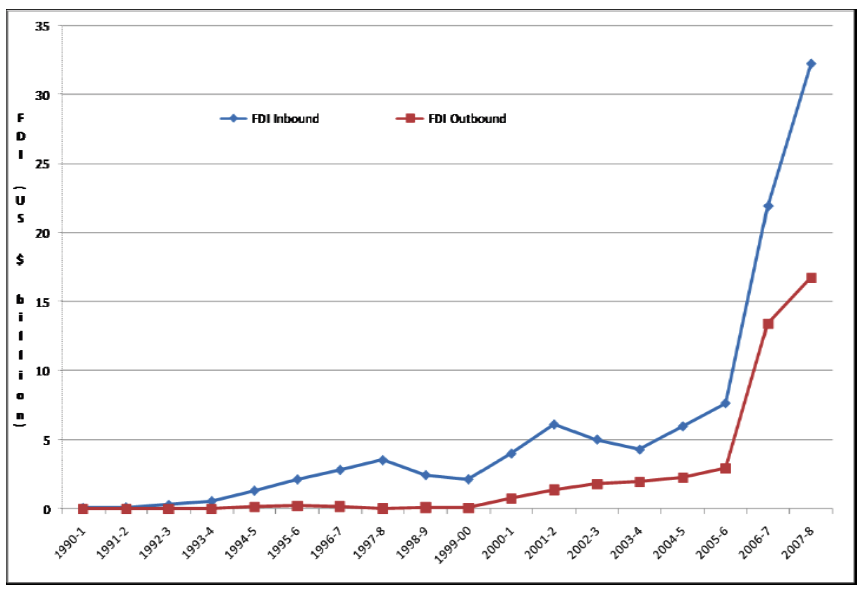
It is evident that the FDI inflows into India surpass the performance of the outflows. This means more investment capital is finding its way into India than the one headed to a foreign destination, particularly as from 2006.
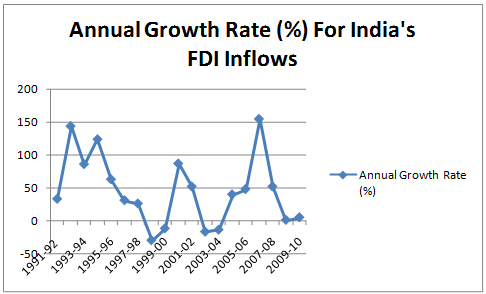
The FDI inflow performance in 1998-99, 1999-00, 2002-03 and 2002-03 indicate negative growth rates. However, it is interesting that at times the FDI inflow went up by more than 100 percent. This implies that FDI inflows experience booms and troughs. Largely, the FDI inflow rate of growth was positive across the years.
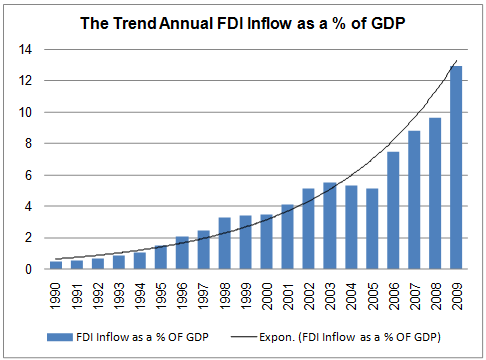
The GDP performance has over the time allowed a positive response to the FDI inflow in India. The exponential growth implies that there is a minimal negative relationship between GDP and FDI inflows. Sahoo & Mathiyazhagan (2002, p. 2) explain that the pattern observed couples FDI inflows with export.
Table 1: Cross-Sector Analysis of FDI Inflows (between 2007 and 2011)
Adopted from Chaturvedi (2011, p. 530).
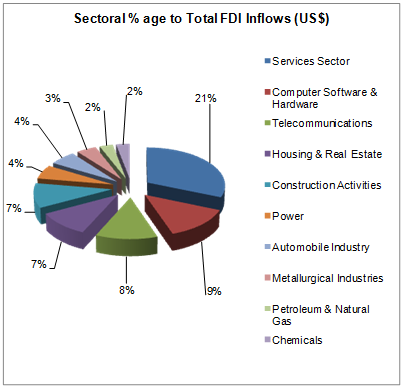
The diversity of sectors attracting significant FDI inflows implies that investor confidence is high across the sector spectrum. The services sector is highly attractive (accounting for a fifth of the FDI inflows). Among the significant sectors, metallurgical industries, petroleum & natural gas as well as chemicals are the least attractive in terms of FDI inflows.
The growth of export commodities in India has not benefited from the FDI inflows boom. Arguably, the larger quota of the FDI inflows finance services sectors, computer software and hardware as well as electronics, which are not major export commodity sources. The manufacturing sector is an export oriented sector in India.
Figure 9: Cross-Country Analysis of FDI Inflows into India Economy (between 2007 and 2011)
Data adopted from Chaturvedi (2011, p. 528).

There is a wide diversity of countries attracted to invest in India; nevertheless, the proportion of FDI contribution differs markedly. The nations in the western hemisphere feature more compared to other parts of the world; though Mauritius leads in the individual category.
Mauritius dominance in the FDI inflows to India began as early as 1995. Mauritius Offshore Companies with an interest in the motor industry in India have led to the high FDI inflows.
Mauritius has a friendly attractive tax scheme for investors targeting foreign markets. The diversity of the nations indicates a wide tolerance or acceptance to India as a FDI destination.
Conclusion
In the pre-liberalization era of the early 1990s, India’s investment policies presented hurdles that limited FDI inflow capacity. Policy and strategic adjustments led to the invigoration of FDI inflow. A range of countries has had their foreign investments in India, particularly Mauritius.
Theoretical approaches in the search for the probable explanation on the relationship between FDI and GDP showed that technology and knowledge transfers provided the key links. This is explained by FDI inflow patterns in the Indian States and the various economic sectors.
References
Agrawal, G & Khan, A 2011, ‘Impact of FDI on GDP: A Comparative Study of China and India’, International Journal of Business and Management, vol. 6, no. 10, pp. 71-79, via International Journal of Business and Management.
Beena, P, Bhandari, L, Bhaumik, S, Gokarn, S, & Tandon, A n.d., Foreign Direct Investment in India. Web.
Chaturvedi, I 2011, Role of FDI in Economic Development of India: Sectoral Analysis. Web.
Hansen, H & Rand, J 2005, On the Causal Links between FDI and Growth in Developing Countries. Web.
Jayachandran, G & Seilan, A 2011, ‘A Causal Relationship between Trade, Foreign Direct Investment and Economic Growth for India’, International Research Journal of Finance and Economics, vol. 42, pp. 74-88, via Eurojournals.
Kareem, P n.d., Foreign Direct Investment and Emerging India. Web.
Nunnenkamp, P & Stracke, R 2008, ‘Foreign Direct Investment In Post-Reform India: Likely To Work Wonders For Regional Development?’, Journal Of Economic Development, pp. 55-84, via JED.
Rao, K & Dhar, B 2011, India’s FDI Inflows: Trends & Concepts. Web.
Sayooo, D & Mathiyayazhagan, M 2002, Economic Growth in India: Does Foreign Direct Investment Inflow Matter? Web.
Sirari, A & Bohra, N 2011, ‘Foreign Direct Investment (FDI) In India Service Sector (A Study of Post Liberalization)’, Int. J. Eco. Res., vol. 2, no. 2, pp. 10-18, via IJER.
Virmani, A 2009, India’s Growth Acceleration: the Third Phase! Web.